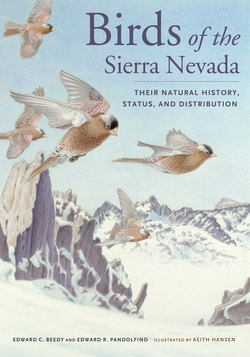Читать книгу Birds of the Sierra Nevada - Ted Beedy - Страница 15
На сайте Литреса книга снята с продажи.
ОглавлениеUnanswered Questions about Sierra Birds
As much as we know about Sierra birds, there is even more we do not know. Unanswered questions abound, and many of these questions offer opportunities for amateur naturalists to make significant contributions. We urge all visitors to the Sierra to take careful notes and record all their observations using eBird (http://ebird.org/content/ebird/). Below we list just a few of these questions. Please refer to the “Family and Species Accounts” section of this book for more details.
What is the current breeding range of the Harlequin Duck in the Sierra?
Recent observations suggest that these rare ducks are beginning to recolonize the Sierra, but all known occurrences are in steep river canyons where most birders never venture. Careful breeding season observations by sturdy hikers who pay attention to birds will give us a much better understanding of their current distribution and conservation status.
What are the current breeding ranges of Ring‑necked Ducks, Buffleheads, and Hooded Mergansers in the Sierra?
In recent years all three of these ducks appear to have extended their breeding ranges farther south into the Sierra than previously thought. Careful breeding season observations at mountain lakes could yield important information on distributional changes of these species.
Are rapidly increasing populations of Eurasian Collared-Doves and Great-tailed Grackles having an impact on other birds?
The rapid expansions of both these species in California seems likely to affect other birds. By making consistent obsevations of numbers of birds in a given area and by recording any changes in their breeding status and behavior, birders could help reveal impacts of these new arrivals.
How many Black Swifts breed in the Sierra?
Although we are aware of only a handful of breeding locations for this species in the Sierra, recent intensive surveys of likely sites (waterfalls with a specific set of characteristics) in the Rocky Mountains revealed many more birds than expected. Exploring similar sites in the Sierra could produce similar results.
Where do Williamson’s Sapsuckers and Pine Grosbeaks spend the winter?
Neither species is commonly found at high elevations in winter. The sapsuckers are occasionally found at lower elevations (even down to the Central Valley) very rarely, but the grosbeaks seem to simply vanish in winter. Hardy birders venturing into the high Sierra in winter, and very observant birders anywhere, could add much to our knowledge of the movements and winter whereabouts of these species.
Do Black-backed Woodpeckers require recently burned forests?
The California Department of Fish and Game is currently evaluating whether this species warrants listing as either Threatened or Endangered. The species apparently prefers intensively burned forests over unburned forests and forests that have burned at lower intensities, but it also uses unburned forests. A better knowledge of their dependence on burned forests, and their occurrence in unburned forests, would be of great value to public agencies and private landowners.
What is the extent of the “return” of Bell’s Vireos to the Sierra?
Previously extirpated from the region, this species appears to be staging a comeback. Birders would do well to learn their distinctive songs and be on alert for new locations, especially in riparian forests of the southern Sierra.
How are Purple Martins faring in the Sierra?
Recent increases in the extent and intensity of wildfires has created more areas with large fire-killed trees (snags) that may provide nesting habitat for martins. Visits to these landscapes in early summer could reveal new nesting locations as well as information about the presence of European Starlings and other competitors for nesting sites.
What are the exact range limits of the two Sierra subspecies of White-breasted Nuthatch?
These subspecies (which may someday be recognized as separate species) have distinct calls, as described in the “Family and Species Account” section of the book. Birders who learn the difference can help us understand the true ranges of these taxa in the Sierra.
What is the range of Pygmy Nuthatches on the West Side?
This species spills over onto the West Side here and there, especially in the northern Sierra. We do not have a precise knowledge of all the places where these nuthatches regularly occur, or of their seasonal status at these locations.
What happened to breeding Ruby-crowned Kinglets and Swainson’s Thrushes in the Sierra?
Formerly fairly common and widespread as breeders, both species have disappeared from most of their historical breeding range in the Sierra. Other populations (kinglets in the Rocky Mountains and thrushes of the Pacific Coast) seem to be stable. Any breeding season observations of these species in the Sierra should be reported via electronic discussion lists and/or eBird.
What are the current breeding ranges of American Pipits and Gray-crowned Rosy Finches in the Sierra?
These species have been confirmed to breed at a handful of high-altitude locations. Birders visiting alpine regions of the Sierra in summer should be on the alert for them, as both species are likely to be affected by climate change.
